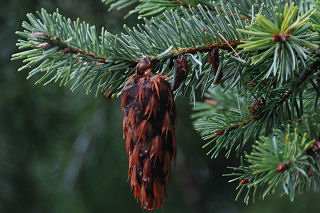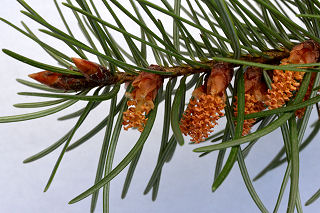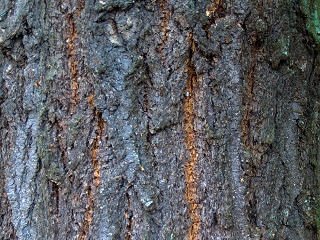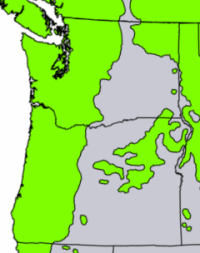
Needles: Douglas Fir is easy to identify. The thin needles stick out in all directions from the twig like a bottle brush. Although the appearance is similar to that of spruce, the needle tips are soft, unlike the sharp spruce needles. If you find a tree growing in the understory, you may see needles that lie flat like a grand fir. Don't let them fool you. Look at the buds. Douglas fir has unique buds that are pointed, reddish-brown and papery.

Cones: The cones are the only ones you will find in the Northwest with three-pointed bracts sticking out of the scales. Unlike the true firs, the cones hang down rather than standing up on the branch. Also unlike the true firs, the Douglas Fir drops its cones to the ground intact. When you see these unique cones on the ground, you know that a Douglas Fir is nearby.

The tiny pollen cones come out in the spring. After dispersing the pollen, they fall, often covering the ground under the trees.
Bark: You can usually identify a large Douglas fir by the bark alone. On large trees, the thick, brown bark is deeply furrowed, more than any other tree in the region. The color is gray to brown and usually brown at the bottom of the furrows.

Where it grows: Douglas fir is the state tree of Oregon and by far the most common conifer in the state. It grows throughout western Oregon and Washington as well as large areas east of the Cascades. It thrives in direct sunlight but is shade intolerant. It naturally propagates from seeds on bare ground in areas destroyed by fire. It is often planted after logging, resulting in extensive stands of pure Douglas Fir. When trying to identify a conifer in western Oregon or Washington, if you guess that it’s a Douglas Fir, you will be right 80% of the time.

Two subspecies of Douglas fir grow in the Northwest:
Names: David Douglas, the Scottish botanist, is honored in the common name for Douglas fir. Another Scott, Archibald Menzies, is honored by the scientific name, menziesii. The genus name, Pseudotsuga, means "false hemlock." Botanists often write the common name as "Douglas-fir" to indicate that it is not a true fir. Other common names: Oregon pine, red fir, and red spruce.

© 2011 Ken Denniston